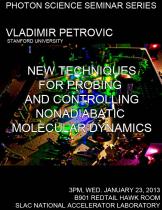Vladimir Petrovic, Stanford University
Conical intersections, loci of degeneracy between electronic states in polyatomic molecules, govern energy dissipation in photoexcited systems ranging from small isomerizing molecules to light harvesting complexes and green fluorescent protein. Ultrafast laser techniques are well suited for studying rapid energy transfer in the vicinity of conical intersections, particularly the nuclear dynamics. We studied isomerization of model system 1,3-cyclohexadiene that involves S 1 /S 0 conical intersection using several time-resolved optical and x-ray techniques. Most recently we reported on an experimental observation of enhanced multiple ionization in intense IR fields around the S 1 /S 0 conical intersection in cyclohexadiene. This observation was made by resolving kinetic energy of ions produced by delayed strong-field IR fragmentation of molecules undergoing isomerization. I will also discuss our plans for an upcoming beamtime that will use extremely short x-ray pulses (<5fs) now available at LCLS to go beyond probing nuclear dynamics and study interactions among electronic states via Auger-launched electronic wavepackets.





